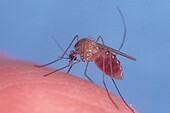
THURSDAY, Sept. 30 (HealthDay News) — In an effort to combat the West Nile virus, an international team of scientists has sequenced the genetic code of the mosquito that transmits the illness to humans.
By deconstructing the genetic composition of the Culex mosquito (also known as the “southern house mosquito”), researchers hope to get a better handle on how the insect is able to carry and transfer a virus it picks up after feeding on infected birds.
This new knowledge could ultimately enable researchers to hone in on, and perhaps disable, the specific genes that allow transmission of the West Nile virus. What’s more, the sequencing effort may bear fruit in terms of halting transmission of other troublesome illnesses, such as St. Louis encephalitis.
A team of scientists drawn from 37 research institutions reports the genetic breakthrough in the Oct. 1 issue of Science.
Scientists previously decoded the genetic makeup of the Anopheles gambiae mosquito and the Aedes aegypti mosquito, which are responsible for the transmission of malaria and yellow fever/dengue fever, respectively.
“We can now compare and contrast all three mosquito genomes, and identify not only their common genes but also what is unique to each mosquito,” co-author Peter Arensburger, an assistant research entomologist from the University of California, Riverside Center for Disease Vector Research, said in a university news release.
“Moreover, now that we have sequenced the Culex genome, we can begin to identify which mosquito genes get turned on or turned off in response to infection,” added Arensburger.
The Culex mosquito can adapt to many types of habitats, and its more than 1,200 species are found all over the world, the researchers note.
Diseases transmitted by the mosquito are difficult to extinguish, given that the birds and animals from which the Culex gets its own infection are readily mobile, allowing for fast dispersal of disease across large swaths of territory.
West Nile virus first appeared in the United States in 1999 and has since spread to all lower 48 states. In the United States last year, 720 people became infected with West Nile virus, the researchers say.
More information
For more on West Nile virus, visit the U.S. Centers for Disease Control and Prevention.

